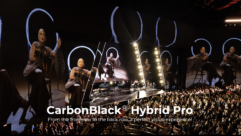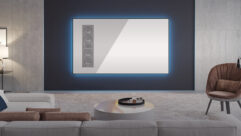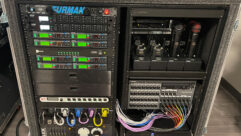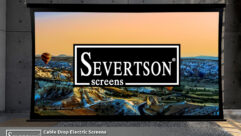
The Changing Tide of Large-venue Projection
Nov 13, 2008 10:36 AM,
By Jessaca Gutierrez
Related News
Technology Showcase: Large HD Projectors

Because of the type of content and the mobility requirement, the Panasonic PT-DW10000U projector worked well for Smash Labs‘ display needs.
SVC recently sat down to discuss large-venue projection with Dan Meehan, systems integration manager for Panasonic, and Peter Coogan, research producer for Smash Lab on the Discovery Channel. As part of the destruction-instruction family of Discovery Channel shows, Smash Lab features a team of maverick engineers as they take on everyday technology and apply it in new ways. First they analyze the technology to see how it works, and then use their know-how to see how it could be used in a different, larger way. Recent episodes have had engineers testing to see if a bulletproof Kevlar could protect a large airplane from an explosion. Another episode would focus on the use of torpedo technology for a mid-ocean rescue attempt. To pull off these type of shows, the team need an integrated mobile computing system as well as a large-venue HD projector to view and produce the stunts and experiments they performed.
The filming and production site was located in a large production area of air hangars and huge outdoor facilities. The producers needed to have a large-scale projector that had a significant amount of lumens, easy maintenance and reliability. They also needed mobile computing solutions that could sustain drops and perform to standards rough environments. Covering an area of 40,000 square feet, the producers projected images in two areas, and in each case had a throw distance of 16ft. During the weeks of production, filming, and reshoots, the crew used the projector for up to 8 hours.
Meehan and Coogan provide some insight into how today’s projection needs are changing in every application, especially when it comes to mobility, from houses of worship and conference needs to TV shows.
SVC: How have large-venue projection needs changed in the last five to 10 years?
Meehan: Over the past five to 10 years, large-venue projection needs have changed tremendously. And it’s only over the past three to five years that the growth from the popularity of high-definition (HD) in home and commercial theater settings have started. Following the consumer HD trend, HD solutions in large-venue settings are also following suit.
Has the demand for video quality for large-venue projection changed? If so, why?
Meehan: Yes. Customers expect to be getting the same high-quality HD content they’re already witnessing from commercial and home-theater venues. Additional large-venue settings such as houses of worship, universities, rental and staging, and businesses are creating and outputting HD content in presentations and services.
The request for 720p or 1080p high-definition technologies in large-venue setting are now becoming the standard and companies like Panasonic Projector Systems Company are answering that demand.
How has mobility impacted need? For example, are more venues seeking out solutions that don’t need to be tied to a permanent infrastructure but are rather a one-time thing?
Meehan: There has definitely been an increase in the demand for mobile projector solutions, however, it all depends on a customers’ needs. Customers utilizing boardrooms, classrooms, or other settings have been more focused on fixed installations in the past. However, at universities, where buildings are older and historic, fixed installations are not permitted and mobile solutions are the only option. It all depends on the customers’ need. Panasonic offers many projector solutions, such as our F series, that can be both mobile and fixed installations all designed to meet the specific needs of our customers .
What was challenging about the Smash Lab installation? What other equipment was required of this installation and how long did the installation take, from spec to finish? Did Panasonic have to provide any help with custom solutions?
Coogan: The lighting director for the show set up the DW10000U Panasonic projector. He was easily able to focus the projector without the help of Panasonic engineers. We shot footage of our own car crashes and projected our own action footage results onto a wall on our set.
Installation required no special equipment. More important, we could play the projector from whatever laptop we had handy—Macs, Motion Computing tablet PCs, and Panasonic Toughbooks. Panasonic had stand-by specialists we could call for help, but we didn’t require custom solutions.
Because of the type of content we were capturing, we had to shoot in a variety of formats like ultra-high speed (+1,000 frames per second), HD cam, SD mini cam, and, because we edited in England, we projected U.K.’s PAL video as well as the U.S. standard NTSC. The ability to output and project these images into one projector, for us, made the use of the DW10000U projector a success.
Considering the demand of HD, where does Panasonic Projectors see the marketplace going in the future?
Meehan: Demand for HD will only continue to grow. HD products will continue to be mainstream and become more affordable for business and consumer. It’s our job as a core manufacturer to work with people such as Hollywood colorists, end users, and our engineers in Japan to listen and understand the demand so that we can continue to provide the best HD projection solutions on the market.










